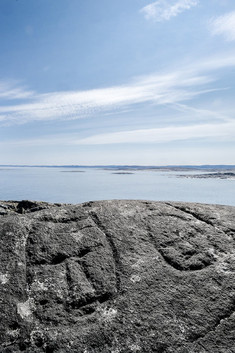Qajartalik site
By Robert Fréchette
Qajartalik site added to the shortlist of places proposed by Canada as UNESCO World Heritage Sites
Westmount, December 22, 2017 – The Qajartalik site is among eight new sites added to the list of places proposed by Canada as UNESCO World Heritage Sites. The announcement was made on December 20th by Catherine McKenna, Canada’s Minister of Environment and Climate Change.
Qajartalik’s application was prepared and submitted by Avataq Cultural Institute, the organization in charge of protecting and promoting Nunavik Inuit culture in Quebec. For over twenty years, Avataq Cultural Institute has been dedicated to the study, recognition and development of a long term protection plan for this site.
Qajartalik is not only the most northern rock art site of the continent, but is truly one of its kind. The petroglyphs found there represent some 180 stylized faces. They are an example of the Dorset people’s impressive creative genius. This is an outstanding cultural pole where the Dorset ‘engravers’ expressed themselves on a large surface by carving faces in the rock mass, in order to communicate their vision of the world – a vision likely connected to the Dorset people’s spiritual universe, and to Paleoeskimo shaman iconographic representations. The Dorset people lived along Nunavik’s coasts between 2,200 to 1,000 years ago. Their disappearance before the arrival of the Inuit (Thule) some 800 years ago is still a subject of debate. The latter have visited the site on a regular basis over the centuries in order to take steatite, the base material for oil lamps, sculptures and tool making.
The site is located in the northeast of the Qikertaaluk Island, on a small peninsula called Qajartalik, meaning “where there is a kayak” in Inuktitut. Qikertaaluk Island is located less than ten kilometers from Quebec’s coast, and about forty kilometers southeast from the community of Kangiqsujuaq.
Qikertaaluk is part of the Nunavik Marine Region. In 2011, after the signing of the Nunavik Inuit Land Claims Agreement between the Makivik Corporation, Nunavut authorities and the Federal Government of Canada, the islands of this area, although still under Nunavut’s jurisdiction, became the property of the Inuit of Nunavik.
The registration of a site on the World Heritage List is the highest recognition of heritage value at the international level.
Avataq Cultural Institute is proud to have Qajartalik on the Canadian list of nomination for UNESCO World Heritage Sites, and hopes that international recognition will help safeguard and enhance one of most valuable sites in the world.
Contact:
Louis Gagnon / Institut culturel Avataq
514 989-9031, poste 246

